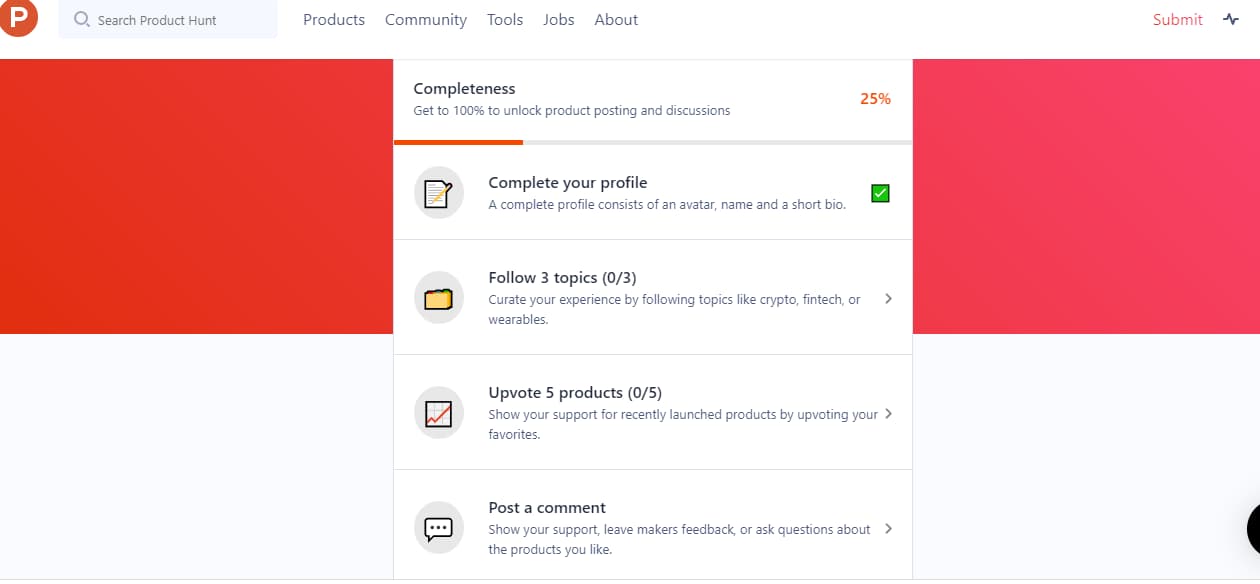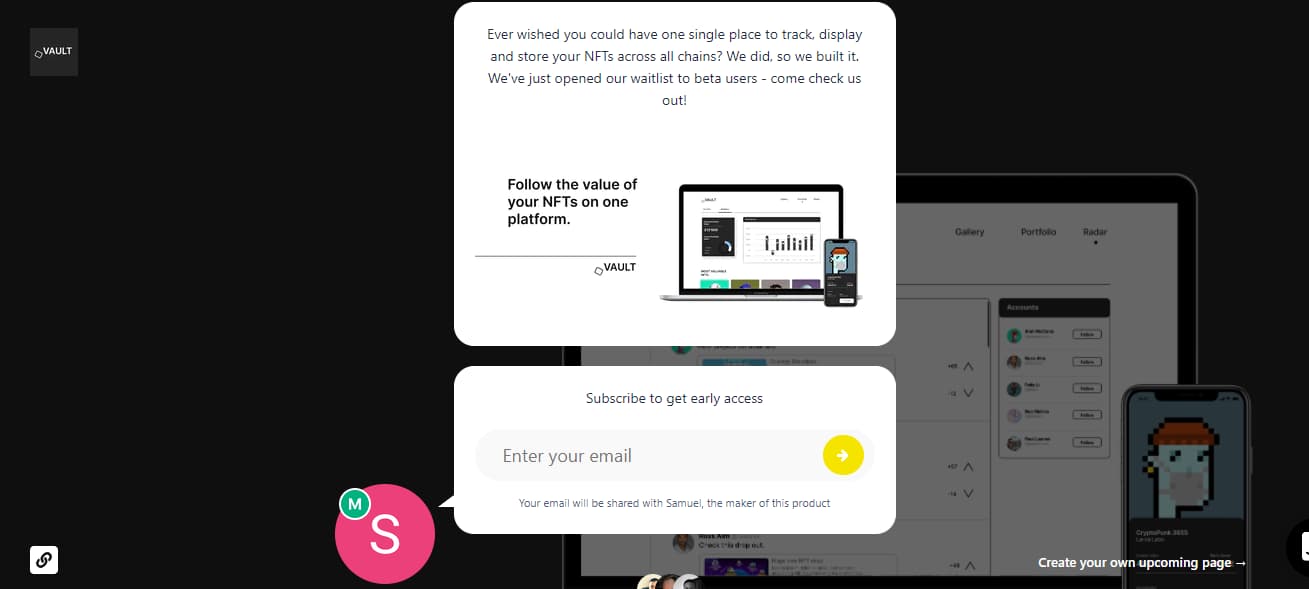A 4-step Product Hunt launch guide to help you become “Product of the Day”
.jpeg)
.png)
.jpeg)
.png)
There's a built-in base of consumers eagerly awaiting the Next Big Thing on Product Hunt. Products like Slack and Trello made a splash on the premier website for product promotion and discovery and rode the momentum from startup to standard, creating new customers and raising boatloads of cash along the way. The problem? There are tens of thousands of companies posting millions of products on the site, so making it to the top of the Product of the Day list can be the difference between Slack-level buzz and no buzz at all.
The potential benefits of scoring big on Product Hunt are worth the effort of adding it to your product’s general launch strategy. However, creating a killer product and an exciting product page aren’t enough by themselves to take your product to the top. The #1 Product of the Day is achieved through upvotes from the Product Hunt community, so anyone hoping to take the top prize will have to appeal to the masses. The good news is that there is a method to the vote-driven madness that is Product Hunt. Following a few simple steps can increase your chances of rising to the top of the Product Hunt charts and starting your product launch off with a bang.
You wouldn’t hire a social media manager who had never used Twitter, LinkedIn, and Facebook. By the same token, you should actively use Product Hunt ahead of your product launch to better understand how to leverage its unique features for a more successful launch.
Product Hunt immediately funnels new users into its onboarding process to help them gain familiarity with how to use the website. First, the site asks if you’re interested in discovering new products or sharing your own products. The uninitiated are then given tasks to complete from the get-go, ranging from setting up a basic profile to following specific topics and leaving comments.

Interacting with posts on Product Hunt gives you a better sense of how to optimize your own product post down the line. As you browse, leave comments, and upvote posts, take note of the common features in the most popular posts. For example, a glance through the highest-rated products reveals that many posts contain:
While your particular product is unique, it undoubtedly fits into overarching categories like “Analytics” or “Task Management.” Browsing these topics helps you identify what tone or content from popular posts in your arena best represents your product and brand and which ones are better avoided.
Product Hunt’s Ship toolkit allows a maker to tease their product ahead of the launch with an Upcoming page. An Upcoming page allows you to introduce your product to other Product Hunt users pre-launch, which drums up buzz while you prepare for kickoff. Networking with the rest of the Product Hunt community helps you use your engagement with other products to draw people to your product. An Upcoming page like Vault’s contains many “best practice” features common to the genre:

The Ship toolkit has one particularly handy feature: it allows you to collect the emails of visitors who have entered them. Even if your launch is weeks away, you can communicate updates about your product to a group of people who have already expressed an interest in your product. Most importantly, you can blast an email out immediately before your official Product Hunt launch to let them know your product page is live.
You can’t have a successful product launch if nobody knows what your product does. Crafting the perfect copy for your post is essential to communicate just why people should be excited about your product. Your post messaging could very well make or break your Product Hunt launch, so it’s best if you craft it well ahead of time.
A Product Hunt post requires:

A successful launch requires a product post that differentiates itself from the hundreds of others being pushed out every week. Your post is the first look most users on the site will have of both you and your product, so it should be a reflection of your values and the value of your product. The best Product Hunt posts marry function with personality, letting the world know not only why they should care about your product but also why they should care about its (and your) success.
Images help to illustrate what your product looks like, how it functions, who uses it, and who designed it. Product Hunt recommends images whose dimensions are set to 1270px by 760px. You must include a minimum of 2 images in your post for the gallery to show up.
Videos are another way to strengthen product posts. A well-executed video can emphasize your product and personality using sounds and images. Videos take time to develop, so planning ahead is important. Product Hunt videos must be embedded as YouTube links, and the usual suggestions for online video still stand:
Keep it short. A study from Vidyard suggests at least half of users will watch a video to the end if it’s under 60 seconds long.
Once you’ve finished creating your post, Product Hunt will ask whether you would like to launch now or schedule for later. You’ll want to schedule it for the future but exactly when depends on your product launch guide and a few Product Hunt-related quirks.
Product Hunt posts new products on their homepage, which can increase visibility and traffic to your post. However, your post will only be pinned to the homepage for a single day. A Product Hunt “day” runs from 12 am to 11:59 pm Pacific Time. Make sure you’re scheduling your post for midnight PT on the date you’d like it to go out to maximize the amount of time your post stays promoted.
Your product has a better chance of ranking higher on Product Hunt if people are anticipating its launch—and it’s up to you to make sure they know it’s coming. Funnel people who may not otherwise use Product Hunt to the page during your launch period to give them a chance to create an account and upvote your product. Your page will even have a section dedicated to showing off your outside media links, which you can gain through:
Your product’s social media channel posts should be tailored specifically to drum up excitement for the Product Hunt launch. An effective post requires momentum: you need to get—and then keep—people talking about your product. Posts leading up to your Product Hunt launch should include the link to your Product Hunt product page, specifically, to ensure prospective customers wind up right where you want them. Your product page also doubles as a landing page in the event you decide to run a paid social campaign to help deliver your message straight to your target audience.

If your company is a startup gearing up to promote its very first product, your devoted social following may be scant. Instead, you could try landing a review or article in an established publication to introduce your product to an interested demographic—research trade publications with an audience that overlaps with your projected product market. From there, query the appropriate point of contact and follow up respectfully if you don’t hear back within several weeks. The process can be slow, but having your product featured in the right magazine can bring valuable awareness not only to your upcoming Product Hunt launch but also to your brand in general.
You’re unlikely to launch your product without thorough testing—both internally and through beta testing. Beta testing not only allows you to work out the kinks in your product but also gives you a built-in user base for your product. While you may only have dozens of beta testers, engaging with them publicly online through forums and social media can help get the snowball of buzz rolling.
Technically, anyone who posts a new product to the site is a hunter. However, while traditional social media platforms have “influencers,” some hunters have built a reputation within the Product Hunt community as eagle-eyed product evaluators. A well-known hunter can be queried through their own websites and blogs to see if they are willing to post your product for you through their own account. This will give your product more clout and more attention than it might receive naturally. Every hunter has their own stipulations, but most will only “hunt” your product if they believe in its value.

A product can only be launched on Product Hunt once. While it’s possible for a product to propel to the top of the charts within a day or week, it may take time before momentum builds to a fever pitch. As such, all cylinders should be firing come launch day—and they should keep firing in the weeks that follow.
On launch day itself:
The last point is especially important as launch day stretches into launch week and beyond. Continuing to engage with comments and questions on your post is a way to keep interest alive within the Product Hunt community. Product, company, or investment updates are also terrific ways to reward the people who have invested time and energy into following your product.
Despite continued product page updates, social posts, and email blasts, eventually, interest will begin to wane. Product Hunt does offer one last-ditch effort to bring attention to your product launch, but for a price. You can pay to sponsor your product to promote it temporarily on the home page and land a feature in Product Hunt’s newsletter. If you have money left in the budget and believe another go-round is worth the shot, the opportunity is there. With careful planning and months of preparation, though, your product launch will have shattered your expectations and launched on Product Hunt to great acclaim and plentiful opportunities.

A successful Product Hunt launch is always subject to the whims of chance. Years ago, several terrific, well-designed products dropped the same day as Slack and now wither in obscurity. There can be only one Product of the Day. Luckily, there are also 365 days in a year. Preparing in advance for a sustained launch can help spark the momentum required to take your product to the top. With a lot of hard work and a little luck, bloggers may one day be writing about the products forgotten in the shadow cast by your own.